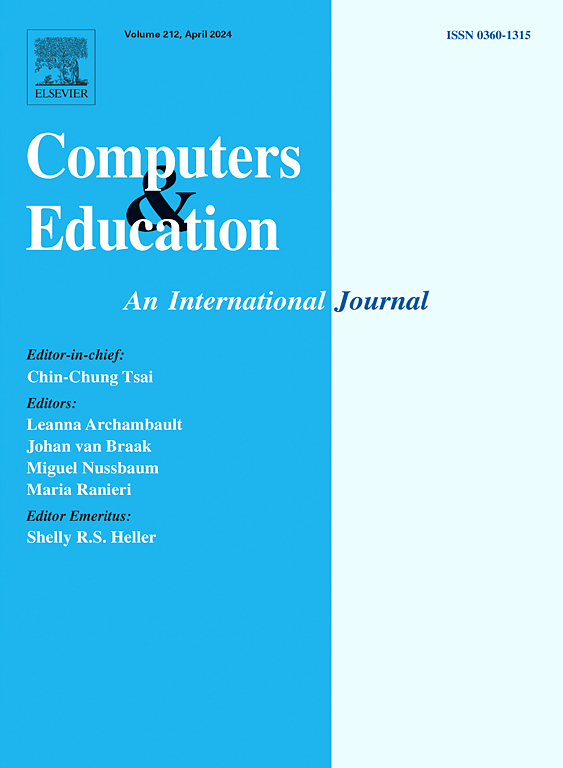媒体多任务处理影响大学生转换但不影响持续注意力的神经关联:来自层次贝叶斯视角的证据
IF 10.5
1区 教育学
Q1 COMPUTER SCIENCE, INTERDISCIPLINARY APPLICATIONS
引用次数: 0
摘要
媒体多任务,即同时参与多种媒体任务,在学生中变得越来越普遍,这引起了人们对其对注意力控制的影响的担忧。在自我调节学习(MASRL)理论的框架下,本研究建立了个人层面的媒体多任务体验与监测和控制的关系,以及任务-人层面的努力调节。通过erp测量结合贝叶斯计算模型,我们比较了重度媒体多任务者(hmm)和轻度媒体多任务者(lmm)在持续注意和注意转换任务中的行为和神经认知差异。结果表明,hmm在注意转换任务(而非持续注意任务)中表现出更快的反应时间。ERP分析显示,在注意转换任务中,hmm的神经反应增强,表明其在认知灵活性上具有加工优势。注意参数α的贝叶斯模型进一步证明了hmm在任务切换过程中更有效地分配了注意资源。这些发现挑战了媒体多任务处理都会损害注意力的观点,提出它可能会促进适应性认知转换策略。这一观点强调了考虑到hmm表现出的认知灵活性,重新思考教育方法的潜力,表明教学可以通过将结构化的生产性任务转换机会与传统的持续注意力活动结合起来而得到加强。数字学习环境可以通过适应学生的个人注意力配置来优化,而有针对性的元认知干预可以帮助学生利用媒体多任务处理的好处,同时减轻其潜在的缺点。通过将认知神经科学与教学实践相结合,本研究为在技术丰富的教育环境中开发更有效的学习策略提供了神经认知基础。本文章由计算机程序翻译,如有差异,请以英文原文为准。
Neural correlates of media multitasking influencing switching but not sustained attention among college students: Evidence from a hierarchical Bayesian perspective
Media multitasking, the concurrent engagement with multiple media tasks, has become increasingly prevalent among students, raising concerns about its impact on attentional control. Within the framework of self-regulated learning (MASRL theory), this study establishes the relationship between person-level media multitasking experience and monitoring and control, along with regulation of effort at the task-person level. Using ERPs measurements combined with Bayesian computational modeling, we compared behavioral and neurocognitive differences between heavy media multitaskers (HMMs) and light media multitaskers (LMMs) during sustained attention and attention-switching tasks. Results revealed that HMMs exhibited faster response times in the attention-switching task (but not sustained attention task) compared to LMMs. ERP analysis showed enhanced neural responses in HMMs during the attention-switching task, suggesting a processing advantage in cognitive flexibility. Bayesian modeling of attentional parameter α further demonstrated that HMMs more efficiently allocated attentional resources during task-switching. These findings challenge the notion that media multitasking uniformly impairs attention, proposing instead that it may foster adaptable cognitive switching strategies. This perspective highlights the potential to rethink educational approaches given the demonstrated cognitive flexibility of HMMs, suggesting that instruction could be enhanced by incorporating structured opportunities for productive task-switching alongside traditional sustained attention activities. Digital learning environments might be optimized by adapting to students' individual attentional profiles, while targeted metacognitive interventions could help students harness the benefits of media multitasking while mitigating its potential drawbacks. By bridging cognitive neuroscience with pedagogical practice, this research provides a neurocognitive foundation for developing more effective learning strategies in technology-rich educational settings.
求助全文
通过发布文献求助,成功后即可免费获取论文全文。
去求助
来源期刊

Computers & Education
工程技术-计算机:跨学科应用
CiteScore
27.10
自引率
5.80%
发文量
204
审稿时长
42 days
期刊介绍:
Computers & Education seeks to advance understanding of how digital technology can improve education by publishing high-quality research that expands both theory and practice. The journal welcomes research papers exploring the pedagogical applications of digital technology, with a focus broad enough to appeal to the wider education community.
 求助内容:
求助内容: 应助结果提醒方式:
应助结果提醒方式:


